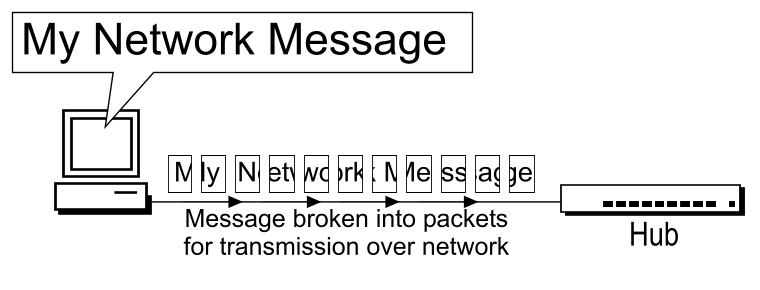Networking
TCP/IP

Networking |
 |
| The University of Findlay's College of Education | |
A protocol is an agreed upon language used by computers communicating over a network. The protocol used by all computers connected to the Internet is Internet Protocol (IP). The full protocol suite used on the Internet is Transmission Control Protocol over Internet Protocol (TCP/IP). For the purposes of this course, we are going to talk just about IP.
When two computers communicate over a network using TCP/IP, each computer must have a unique identifier that distinguishes it from other computers on the network. On the Internet, every computer is assigned a unique Internet Protocol (IP) number. An IP number is a 32-bit number composed of four 8-bit pieces (octets) separated by "dots" or decimal points. An IP number will look something like
199.117.144.10
This particular IP address belongs to
www.network.com
Each of the four parts of the IP address may have a value from 0 to 255. So the smallest IP number will be
0.0.0.0
and the largest IP number will be
255.255.255.255
There are 256 possible values for each number. That is two to the power of eight; eight-bits. There are some simples rules that must be followed when assigning IP addresses.
1. No two computers on the entire Internet may have the same IP address.
2. All computers on a network segment must have the same subnet mask. See Subnetting for more details.
3. An IP address cannot start or end with a zero. Zero's may be used in the two middle octets.
Not valid
0.10.10.10
10.10.10.0
Valid
10.0.0.1
4. An IP address cannot contain the number 255.
Not Valid
255.10.10.10
10.255.10.10
10.10.255.10
10.10.10.255
Packets
When a message is sent across the network, it is broken into small pieces called packets. If one packet is lost on its way to the destination, only that packet is re-transmitted. This is more efficient than re-transmitting the whole message.

The size and structure of these packets is determined by the exact networking technology used. Ethernet will have a packet that is different than an ATM packet. For the purposes of this course, the simple packet diagram below will be sufficient.

When a packet of information moves across the network, the router on the network will exam the IP address portion of the packet, and move the packet onto the network segment which contains the computer with the destination IP address. Once on the correct segment, switches will look at the MAC address to move the packet to the correct destination NIC. The CRC is error-checking information. The destination NIC will look at the CRC to determine if the packet was corrupted during transit. If there is a problem with the packet, it will be re-transmitted.
Other important IP numbers
127.0.0.1 Loopback Address - always refers to your local machine 0.0.0.0 Used for computers that use BOOTP or DHCP 169.254.X.Y Auto-configuration range - A NIC will auto-assign an IP address in this range if the NIC is configured for DHCP and a DHCP server is not available. Apple uses this range for Rendezvous. 255 Any IP address with a 255 is invalid
These addresses are not routed on the Internet (see Private Networks):
10.X.X.X Class A - 1 range - 16 million total addresses 172.16.X.X - 172.31.X.X Class B - 16 ranges - 1 million total addresses 192.168.X.X Class C - 256 ranges - 65 thousand total addresses